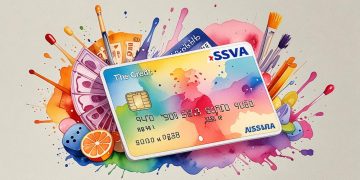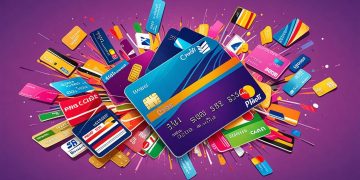The Importance of Financial Education in Choosing and Using Credit Cards

Understanding Credit Cards
In today’s consumer-driven economy, understanding credit cards is essential for financial stability. The ability to effectively choose and manage credit cards can significantly impact one’s financial health. With the right financial education, consumers can leverage credit cards to their advantage. A credit card is not merely a payment tool; it provides opportunities for rewards, improved credit ratings, and financial flexibility when used responsibly.
- Managing Debt: Knowledge about interest rates and repayment terms helps in avoiding excessive debt. It is crucial to understand how credit card interest rates, often referred to as Annual Percentage Rates (APRs), can accumulate if balances are not paid in full each month. For example, carrying a balance on a credit card with a 20% APR can lead to significant costs, compounded monthly. Using tools such as balance calculators can help consumers visualize the long-term implications of minimum payments versus paying more towards their balances.
- Building Credit Score: Responsible use of credit cards aids in enhancing creditworthiness. Payment history accounts for 35% of a credit score, making on-time payments critical. Additionally, keeping credit utilization below 30% of the credit limit is advisable. For instance, if a consumer has a credit limit of $10,000, they should aim not to exceed $3,000 in outstanding balances to maintain a healthy credit score.
- Understanding Fees: Awareness of annual fees, late payment penalties, and foreign transaction charges prevents unnecessary costs. Many credit cards assess annual fees, especially those offering premium rewards; consumers should weigh these against the benefits. Understanding the terms and conditions of strong purchase protections, cash back incentives, or travel rewards are equally important when assessing the value of a credit card.
Financial education equips consumers with the tools needed to make informed decisions. By understanding the features of different credit cards, individuals can select cards that best fit their financial goals. For example, a frequent traveler may find more value in a rewards card that offers points on travel expenses, while someone who primarily uses credit for everyday purchases might benefit from a cash-back card.
This education also encompasses the potential risks associated with credit card use, ensuring that consumers are prepared to act responsibly. Mismanagement can lead to debt accumulation and negatively affect credit scores. As such, it is essential to seek out resources, such as financial literacy workshops or online courses, to enhance understanding and management of credit cards.
Ultimately, the importance of financial literacy in this context cannot be overstated. It lays the groundwork for sound financial decisions and empowers individuals to take control of their financial future. With the right knowledge, credit cards can become powerful tools rather than potential sources of financial distress. By educating themselves, consumers can navigate the complexities of credit card use to ensure that they enhance rather than hinder their financial well-being.
DIVE DEEPER: Click here to discover the importance of financial literacy
Key Factors in Selecting a Credit Card
When considering the myriad of credit card options available, consumers must evaluate several key factors to ensure their choice aligns with their financial situation and goals. Financial education provides the framework for understanding these factors and making informed selections that can lead to long-term benefits.
- Interest Rates: One of the most critical aspects to assess when selecting a credit card is the interest rate, commonly stated as the Annual Percentage Rate (APR). The APR determines the cost of borrowing if balances are not paid in full. Credit cards may offer varied rates based on creditworthiness; consumers should shop around and compare offers to identify cards with competitive rates. For instance, cards designed for individuals with excellent credit may feature lower interest rates, which is advantageous for those who might carry a balance.
- Rewards Programs: Many credit cards come with rewards programs that can enhance the value of card usage. These programs might include cash back, travel rewards, or points redeemable for merchandise. It is essential for consumers to consider how their typical spending aligns with specific rewards categories. For example, a consumer who frequently dines out may benefit from a card offering increased cash back on restaurant purchases, whereas a person who travels often might prioritize a travel rewards card.
- Fees and Charges: An understanding of the associated fees is crucial for cost-effective credit card management. Common fees include annual fees, late payment fees, and cash advance fees. Some credit cards are marketed as fee-free options, but they may come with other drawbacks such as higher interest rates or fewer rewards. Consumers should calculate the overall cost of a card by weighing these fees against potential benefits from the rewards or features offered.
In addition to these factors, consumers should also carefully review the card’s terms and conditions, focusing on the grace period and the implications of carrying a balance. The grace period—the timeframe in which payments are made without incurring interest—is a significant consideration for budgeting effectively. Being informed about policies regarding payments, such as changes in APR or how late payments affect fees, can further aid in managing debts.
Moreover, consumers should be aware of the impact that their credit card choices can have on their credit scores. Each time a card application is submitted, a credit inquiry is placed on the consumer’s credit report, potentially affecting their score. Understanding the implications of multiple applications and the importance of maintaining a healthy mix of credit can help guide consumers in making prudent choices.
Ultimately, equipping oneself with financial knowledge about choosing the right credit card is a foundational step in establishing a responsible and beneficial credit management strategy. This knowledge not only assists in selecting the appropriate credit card but also encourages responsible usage, which is essential in maintaining financial health in the long term.
DISCOVER MORE: Click here to learn how to apply easily
Utilizing Financial Education for Responsible Credit Card Management
Beyond the initial selection of a credit card, effective financial education serves as a crucial tool in managing and utilizing credit responsibly. It ensures that consumers understand the intricacies of credit card operations, applications, and the significant implications that arise from their use.
- Understanding Credit Utilization: A fundamental concept in credit management is credit utilization, which refers to the ratio of credit card balances to credit limits. Financial experts recommend maintaining a utilization rate below 30% of the total credit limit to foster a positive credit score. For example, if a consumer has a total credit limit of $10,000, they should strive to keep their outstanding balance under $3,000. Educated consumers will not only track their spending diligently but also maintain low utilization rates to enhance their financial stability and creditworthiness.
- Timely Payments: The importance of making payments on time cannot be overstated. Payment history is a significant factor in determining credit scores, often accounting for around 35% of the overall score. Late payments can incur fees and interest rates that significantly increase the cost of borrowing. Financial education empowers consumers to integrate payment due dates into their financial planning, utilize reminders, or automate payments where feasible to ensure timely bill settlement. Educated consumers are more likely to avoid the pitfalls of late fees, which can average between $25 to $39 per missed payment.
- Leveraging Grace Periods: Many credit cards offer a grace period during which purchases accrue no interest if the balance is paid in full by the due date. Understanding and utilizing this grace period can be advantageous, allowing consumers to effectively manage cash flow and avoid interest charges. Financial education teaches consumers to calculate their monthly spending to take full advantage of the grace period, thus aiding in efficient budgeting.
- Monitoring Credit Reports: Staying informed about one’s credit health is integral to responsible credit card usage. Consumers are entitled to request a free credit report annually from each of the three major credit bureaus: Equifax, Experian, and TransUnion. Awareness of one’s credit report allows for timely identification of errors or fraudulent activity that could harm an individual’s credit score. Financial literacy encompasses tools and resources for monitoring credit scores and reports, enabling consumers to make adjustments and rectify discrepancies promptly.
Moreover, understanding the nuances of credit card benefits can turn ordinary consumption into insightful financial strategies. For example, informed consumers may take advantage of introductory offers such as 0% APR on balance transfers or purchases for a specified period. However, it is essential to grasp the full terms of such offers, including the duration of the promotional APR and the regular APR post-introductory period, to avoid unexpected costs.
Through continuous financial education, consumers can also hone skills in distinguishing between necessity and luxury spending, helping prevent over-reliance on credit. This knowledge further promotes a culture of mindful spending and informed borrowing, leading to improved financial outcomes.
DISCOVER MORE: Click here to learn how to navigate inflation
Conclusion
In today’s consumer-driven society, the importance of financial education in choosing and using credit cards cannot be overstated. The ability to make informed decisions regarding credit card selection and usage is essential for fostering long-term financial health. By understanding key concepts such as credit utilization, the significance of timely payments, and the benefits associated with grace periods, consumers can effectively manage their credit and safeguard their credit scores.
Moreover, regular monitoring of credit reports empowers users to address issues proactively and enhances their financial literacy. As consumers navigate the complex landscape of credit cards, financial education equips them with the tools needed to distinguish between necessary and discretionary spending, thereby promoting responsible borrowing practices. It is also crucial for consumers to grasp the full implications of promotional offers, ensuring they avoid pitfalls associated with unexpected charges.
Ultimately, the journey toward financial literacy is ongoing, requiring continuous learning and adaptation. With a firm grasp of credit management principles, consumers can not only enhance their creditworthiness but also make empowered financial decisions that contribute to their overall economic well-being. By prioritizing financial education, individuals can transform their relationship with credit cards from a source of potential debt into a valuable asset that supports their financial goals.









